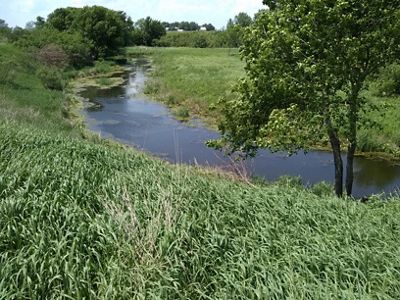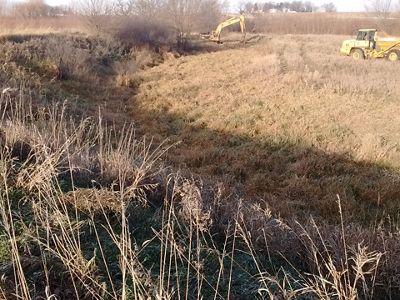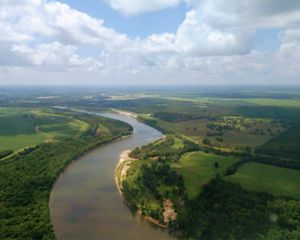Breathing Room for Freshwater
TNC and partners are restoring wetlands through strong partnerships to reduce flood risk and improve water health.

In 2008, days of heavy rain caused the Cedar River to flood, inundating downtown Cedar Rapids and displacing more than 18,000 residents.
No lives were lost in the disaster, but the flood illustrated the vulnerability of the second largest city in Iowa. The river crested at a record 31.12 feet, floodwaters swirled through more than 10 square miles of the city and firefighters used boats to rescue 423 people. An estimated 1,360 people ultimately lost their jobs.
Since that devastating deluge, the City of Cedar Rapids decided to proactively mitigate flood risk. They turned to The Nature Conservancy to help them diversify their protection strategies and make broad, landscape-scale changes to lessen the risk of future floods.
Quote: Karen Wilke
Flooding is a statewide challenge, and no single group can solve it alone. That's where TNC comes in. We can help bridge the gaps, bringing partners together and creating innovative solutions that improve water quality and strengthen our rivers, wetlands and lakes.


What is an Oxbow?
An oxbow is a meander of a stream or river that has been separated from the flow of water.
Learn MoreFloods are normal, and to a certain extent, healthy. “But we’ve channelized water and expect it to stay in those channels and behave itself,” says Mary Beth Stevenson, watersheds and source water program manager for the city of Cedar Rapids.
To find solutions, the city and TNC looked upstream. There, they realized, they could slow the flow of floodwaters by scooping out and restoring some of the area’s sediment-filled oxbows, the U-shaped wetlands that form when a meandering stream or river cuts a straighter path and leaves a section of waterway that is separated from the main flow. Restoring these wetlands can bring many benefits.
Quote: Mary Beth Stevenson
Oxbows create space for water to breathe. We love oxbows because they create pockets for water storage in the landscape.
Oxbows can hold up to 1 million gallons of floodwater per acre, slowing raging waters before they spill into nearby streams and rivers. They also sequester an estimated 1.34 tons of carbon per acre, minimizing the impacts of a changing climate.
A single oxbow won’t stop flooding entirely, but when oxbows across the watershed are restored, they can collectively help the landscape become more resilient, Stevenson says.
And that’s not all. Much of the watershed around Cedar Rapids, and throughout Iowa, suffers from high nitrate levels, which have been linked to health issues. Oxbows naturally filter out those excess nutrients, ultimately providing safer water for drinking for the nearly 130,000 people who live in the Cedar Rapids area.
“What we’re doing is partnering with farmers to protect community drinking water supplies,” Stevenson says. The city is using funds from the Natural Resources Conservation Service to help farmers cover the costs of implementing these conservation practices. They’ve also hired a conservation agronomist to work with area farmers on fertilizer management.
For more than 10 years, TNC has partnered with the City of Cedar Rapids on some of those upstream wetland restorations. Now, that vision is expanding. TNC has identified an additional 1,142 potential high-value oxbow sites. Over the next decade, the goal is to bring back 500 acres of these critical ecosystems throughout the Cedar River watershed. “Partnerships like the one between Cedar Rapids and TNC are a really great example of how we’re all working together to solve these big landscape-scale problems,” Stevenson says.
It’s work that TNC supports, because it not only slows floodwaters and helps remove excess nutrients and provides critical habitat for fish, including the federally endangered Topeka shiner, and migratory birds in a biologically diverse part of the state. Restored oxbows are great places for people to fish, hunt and view wildlife, too.
Stay in the Loop.
Get conservation stories, news and local opportunities from where you live.
Farmer Brian Bourgeois, a current TNC board member in Iowa, says that factored into his decision to restore an oxbow on his property in Cedar and Johnson counties.
“We were looking for a conservation practice that, for a relatively small cost, would provide an outsized impact on nature by reintroducing a habitat that was diminished across the Iowa landscape,” Bourgeois says.
He found that restoring an oxbow would meet those goals of mitigating flood risk, maintaining biodiversity, and filtering out nutrients. It also would provide another place for wildlife to drink and cool off.
“We restored our oxbow less than a year ago, and it is already teeming with wildlife and a diverse mix of wetland plants,” Bourgeois says. He’s spotted softshell turtles, muskrats, river otters, waterfowl, frogs, deer and more at the site.

Bourgeois says he believes it’s important to conserve and protect the land and water upon which all life depends, and the project is work he’s proud of.
“Farmers have strong ties to the soils and water they depend on, and taking care of the environment is very gratifying,” he says.
Of course, oxbows aren’t the only answer. They’re one piece of a bigger effort, and change takes multiple approaches and strong partnerships.
The good news? Those partnerships are growing, and together we’re proving that when we share the same goals, we can create cleaner rivers, safer communities and a future where nature and people thrive side by side.




